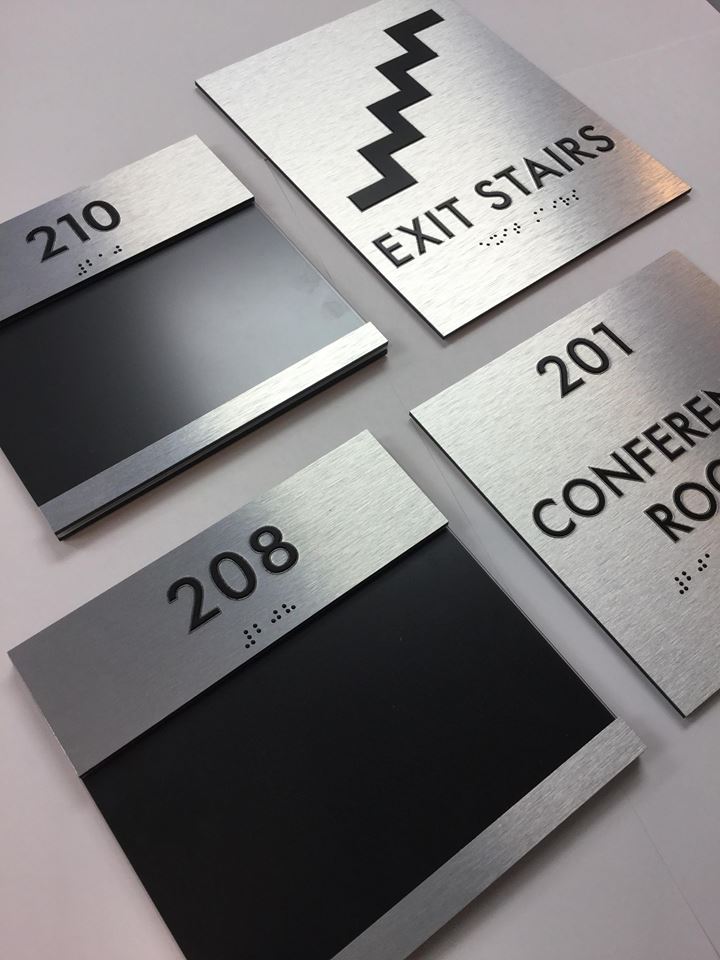The Advantages of Using Top Notch ADA Signs in Your Organization
The Advantages of Using Top Notch ADA Signs in Your Organization
Blog Article
Checking Out the Secret Features of ADA Signs for Enhanced Accessibility
In the world of availability, ADA signs serve as quiet yet powerful allies, ensuring that areas are navigable and comprehensive for individuals with specials needs. By incorporating Braille and responsive elements, these indications damage obstacles for the visually impaired, while high-contrast color systems and legible typefaces cater to diverse aesthetic needs.
Significance of ADA Conformity
Ensuring conformity with the Americans with Disabilities Act (ADA) is important for cultivating inclusivity and equal accessibility in public rooms and workplaces. The ADA, passed in 1990, mandates that all public centers, companies, and transport services accommodate individuals with specials needs, guaranteeing they enjoy the same legal rights and chances as others. Conformity with ADA requirements not just meets lawful commitments but also enhances an organization's track record by showing its dedication to variety and inclusivity.
Among the key aspects of ADA compliance is the application of obtainable signs. ADA signs are developed to guarantee that individuals with specials needs can quickly browse via rooms and structures. These indications need to comply with details standards relating to dimension, font style, color contrast, and placement to guarantee presence and readability for all. Correctly carried out ADA signage assists remove obstacles that individuals with specials needs commonly come across, consequently promoting their independence and self-confidence (ADA Signs).
Additionally, adhering to ADA guidelines can mitigate the danger of prospective fines and lawful repercussions. Organizations that fall short to adhere to ADA standards may face fines or suits, which can be both harmful and financially difficult to their public image. Therefore, ADA conformity is essential to cultivating an equitable setting for everyone.
Braille and Tactile Aspects
The consolidation of Braille and responsive components right into ADA signage symbolizes the concepts of accessibility and inclusivity. It is generally put underneath the equivalent message on signs to make certain that people can access the details without visual aid.
Tactile components expand beyond Braille and include raised icons and personalities. These elements are designed to be discernible by touch, allowing individuals to recognize area numbers, bathrooms, departures, and other crucial areas. The ADA establishes certain guidelines regarding the dimension, spacing, and positioning of these tactile components to maximize readability and guarantee consistency throughout various atmospheres.

High-Contrast Color Design
High-contrast shade plans play a pivotal function in enhancing the exposure and readability of ADA signage for people with visual problems. These schemes are crucial as they maximize the distinction in light reflectance in between text and history, guaranteeing that indicators are easily noticeable, even from a distance. The Americans with Disabilities Act (ADA) mandates using particular shade contrasts to accommodate those with restricted vision, making it an essential element of compliance.
The efficiency of high-contrast shades lies in their capability to stand out in different lights conditions, including poorly lit environments and areas with glow. Typically, dark text on a light history or light message on a dark background is utilized to accomplish optimum contrast. For example, black message on a white or Check This Out yellow history gives a stark visual distinction that aids in quick acknowledgment and understanding.

Legible Fonts and Text Size
When thinking about the style of ADA signs, the option of readable typefaces and appropriate text size can not be overstated. These elements are important for making sure that signs are accessible to individuals with aesthetic problems. The Americans with Disabilities Act (ADA) mandates that typefaces must be sans-serif and not italic, oblique, manuscript, very attractive, or of uncommon type. These demands assist make certain that the message is conveniently understandable from a distance and that the characters are appreciable to diverse target markets.
The dimension of the text additionally plays a pivotal duty in availability. According to ADA guidelines, the minimum message height should be 5/8 inch, and it needs to boost proportionally with seeing range. This is particularly crucial in public spaces where signage requirements to be read rapidly and precisely. Consistency in message size adds to a cohesive aesthetic experience, helping individuals in browsing environments successfully.
Furthermore, spacing in between lines and letters is important to readability. Sufficient spacing protects against characters from showing up crowded, boosting readability. By sticking to these standards, developers can considerably enhance accessibility, making sure that signs offers its intended function for all people, despite their visual abilities.
Reliable Placement Techniques
Strategic positioning of ADA signs is important for optimizing access and ensuring compliance with lawful requirements. Effectively positioned signs assist people with disabilities efficiently, assisting in navigating in public rooms. Trick considerations include closeness, presence, and elevation. ADA standards specify that indicators should be installed at a height in between 48 to 60 inches from the ground to ensure they are within the line of view for both standing and seated people. This conventional elevation array is essential for inclusivity, enabling mobility device customers and people of differing elevations to gain access to info effortlessly.
Additionally, indicators have to be put adjacent to the latch official statement side of doors click to investigate to permit easy recognition before access. Consistency in indicator placement throughout a center enhances predictability, minimizing confusion and enhancing overall individual experience.

Verdict
ADA signs play a crucial duty in promoting availability by incorporating features that deal with the demands of people with specials needs. Incorporating Braille and tactile aspects makes certain critical info is obtainable to the aesthetically damaged, while high-contrast color schemes and clear sans-serif font styles boost presence throughout various lighting conditions. Effective placement methods, such as ideal placing elevations and tactical places, additionally assist in navigating. These components jointly promote a comprehensive atmosphere, highlighting the value of ADA conformity in making certain equivalent gain access to for all.
In the world of availability, ADA signs offer as quiet yet powerful allies, ensuring that rooms are inclusive and accessible for individuals with specials needs. The ADA, enacted in 1990, mandates that all public centers, employers, and transport services accommodate people with handicaps, ensuring they enjoy the very same legal rights and opportunities as others. ADA Signs. ADA indicators are made to make sure that individuals with disabilities can quickly navigate via areas and buildings. ADA standards stipulate that indicators ought to be placed at a height in between 48 to 60 inches from the ground to ensure they are within the line of view for both standing and seated individuals.ADA indicators play an important duty in promoting access by integrating attributes that deal with the demands of individuals with handicaps
Report this page